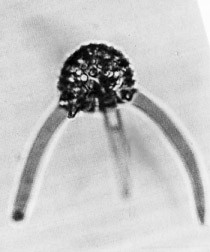 Tristylospyris
triceros (Ehrenberg)
Tristylospyris
triceros (Ehrenberg) Tristylospyris
triceros (Ehrenberg)
Tristylospyris
triceros (Ehrenberg)Ceratospyris triceros Ehrenberg, 1873, p.220; 1875, pl.21, fig.5
Tristylospyris triceros (Ehrenberg), Haeckel, 1887, p.1033; Riedel, 1959, p.292, pl.1, figs.7-8
Shell nut-shaped, tuberculate, thick-walled, with indistinct sagittal stricture, and with subcircular to circular pores without regular arrangement. Three primary feet robust, circular in section, curved, with convexity outward. Secondary feet, which are not developed in all specimens, are one to seven in number (usually three), of the same general form as the primary feet but smaller. Rarely a small apical horn is present. The few specimens that could be observed from the base were found to have three large and six small collar pores such as Bütschli (1882) described for Petalospyris argiscus Ehrenberg, and the three primary feet correspond in position with the bars separating the three large pores (Riedel, 1959).
Based on 30 specimens. Length of shell 68-88 µm; of primary feet 155-415 µm; of secondary feet 18-105 µm. Breadth of shell 88-105 µm (Riedel, 1959).
Cephalis without horn. Three equally large, divergent, slightly curved cylindro-conical feet, alternating with (usually three) shorter ones that may be tabular (Riedel and Sanfilippo, 1978a).
This species differs from its descendant Dorcadospyris ateuchus by having three primary feet rather than two (Sanfilippo et al., 1985).
The nut-shaped lattice-shell bears three strong, cylindrical primary feet, varying from slightly divergent with most of the curvature proximally and almost straight distally, to semicircularly curved. The three (or occasionally more) secondary feet are shorter, varying in form from cylindro-conical to lamellar. Rare specimens have a small apical horn (Sanfilippo et al., 1985).
Tristylospyris triceros is common in assemblages of late middle Eocene through early Oligocene age from low and middle latitudes of all ocean basins. Its morphotypic first appearance is approximately synchronous with the lower limit of the Podocyrtis chalara Zone. Its evolutionary transition to Dorcadospyris ateuchus defines the base of the Dorcadospyris ateuchus Zone.
Tristylospyris triceros appears to have evolved from a middle Eocene ancestor having six similar primary feet. It is the ancestor of Dorcadospyris ateuchus.
Additional illustrations can be found in Ling, 1975, pl.6, figs.1-6; Moore, 1971, pl.6, figs.1-3.